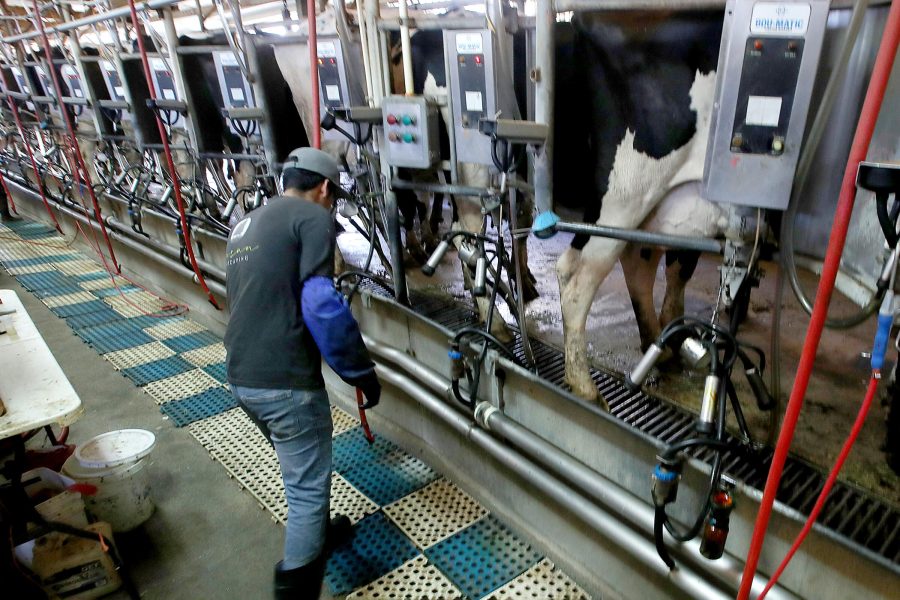Uncover the implications of the USDA’s $824 million plan to fight High Path Avian Flu amid the diagnosis of a third dairy worker in the U.S. What does this mean for the future of livestock safety?

The high Path Avian Influenza (HPAI) outbreak in Michigan has escalated with the diagnosis of a third dairy worker. This worker, who reported respiratory symptoms, is now in recovery. It’s crucial to note that there is no evidence of human-to-human transmission, a key factor in assessing the overall risk. However, health officials warn that workers in close contact with infected animals are at a higher risk of contracting the virus, underscoring the severity of the situation.
In this latest case, the affected dairy worker experienced various respiratory symptoms, including coughing, shortness of breath, and mild fever, which are common symptoms of HPAI in humans. Fortunately, the worker is in recovery and steadily improving. Critical to note: No evidence suggests human-to-human virus transmission in this instance. Health officials emphasize that the risk to the general public remains low, thanks to stringent precautionary measures protecting those in close contact with infected animals. This comprehensive approach underscores the commitment to safeguarding both animal and public health while maintaining the resilience of the dairy industry.
The heightened risk for workers exposed to infected animals, such as those in the dairy and poultry industries, cannot be understated. These individuals face a significantly elevated risk of contracting HPAI due to their close and continuous contact with specific types of birds, such as chickens and turkeys, which are known carriers of the virus. The virus spreads through direct contact with infected birds or inhalation of contaminated particles, making the environment highly dynamic and challenging. Stringent safety protocols and preventive measures have been instituted to mitigate these risks. Health officials recommend using personal protective equipment (PPE) like masks, gloves, and eye protection. Regular health screenings and surveillance systems quickly identify and isolate potential cases among workers. Enhanced biosecurity measures include controlled farm access points, disinfection stations, and strict sanitary practices. Ongoing training programs ensure workers are well-informed about HPAI symptoms and necessary actions if exposure is suspected.
The USDA’s recent announcement to provide $824 million in funding is a significant boost to the voluntary program for dairy producers in monitoring and mitigating HPAI spread. This financial support is instrumental in catalyzing a multifaceted approach toward disease control, with advanced surveillance technologies and comprehensive data collection mechanisms at its core. Real-time monitoring systems will enable early detection and swift intervention, a crucial step in disease control. The funding also allows for the development of more effective vaccines and the implementation of robust biosecurity protocols, further enhancing the control measures.
The program also emphasizes robust biosecurity protocols, including stringent farm access restrictions, mandatory disinfection routines, and rigorous waste management practices. Enhanced education and training sessions ensure all farm personnel can recognize early HPAI symptoms and adhere to best containment practices. This is complemented by a rapid response framework incorporating emergency vaccination drives and strategic culling operations to curtail the outbreak swiftly. Dedicated research funding focuses on developing effective vaccines and understanding the virus’s transmission dynamics.
The importance of these measures in controlling the outbreak cannot be overstated. Early detection, timely intervention, and comprehensive education, all part of a well-structured plan, protect dairy workers and fortify the resilience of the nation’s dairy supply chain. Ultimately, these enhancements safeguard public health and the agricultural economy against HPAI’s pervasive threat, providing a sense of security in these challenging times.
In summary, diagnosing a third dairy worker in Michigan with High Path Avian Influenza shows the need for ongoing and strategic efforts. The USDA’s funding of $824 million is crucial in fighting this disease. It allows for faster response times, more vaccine research, and robust food safety measures. These actions aim to protect dairy workers at higher risk and support the United States agricultural infrastructure.
As we grapple with this outbreak, it’s essential to maintain ongoing vigilance and support for those on the front lines. The strength of our dairy supply chain and public health hinges not only on the efforts of individuals but on our collective commitment to protecting both the producers and the wider community. Continued teamwork and proactive measures will be pivotal in handling and overcoming the threat of HPAI.
Key Takeaways:
- A third dairy worker in Michigan has been diagnosed with HPAI, currently recovering and showing respiratory symptoms.
- There is no evidence of human-to-human transmission, maintaining a low risk for the general public.
- Health officials stress that individuals in close contact with infected animals, such as agricultural workers, face higher risks.
- To combat HPAI, the USDA is allocating $824 million towards enhancing response efforts, supporting vaccine research, and ensuring food safety.
- Enhanced measures include personal protective equipment, regular health screenings, enhanced biosecurity, and ongoing training programs for workers in the dairy and poultry industries.











